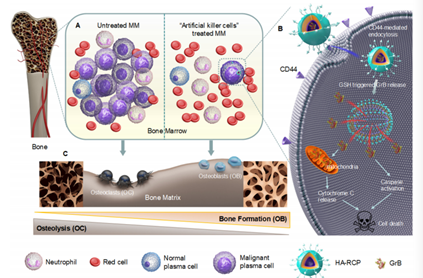Welcome to College of Chemistry, Chemical Engineering and Materials Science of Soochow
University
CD44-targeted vesicles encapsulating granzyme B as artificial killer cells for potent inhibition of human multiple myeloma in mice
Yinan Zhonga,b , Fenghua Menga,*(孟凤华) , Wen Zhangc , Bin Lic,d , Jan C.M. van Heste , Zhiyuan Zhonga, *(钟志远)
a Biomedical Polymers Laboratory, College of Chemistry, Chemical Engineering and Materials Science, State Key Laboratory of Radiation Medicine and Protection, Soochow University, Suzhou 215123, PR China b Department of Pharmaceutical Engineering, School of Engineering, China Pharmaceutical University, Nanjing 211198, PR China
c Orthopedic Institute, Soochow University, Suzhou 215007, PR China
d Department of Orthopaedic Surgery, the First Affiliated Hospital of Soochow University, Suzhou 215006, PR China
e Eindhoven University of Technology, P.O. Box 513 (STO 3.31), 5600MB Eindhoven, the Netherlands
Journal of Controlled Release 320 (2020) 421--430
Multiple myeloma (MM) is a malignant blood cancer homing in bone marrow that is particularly hard to treat. The effective treatment for MM shall be not only MM-selective but also capable of homing to bone marrow. Herein, we report on hyaluronic acid-directed reduction-responsive chimaeric polymersomes encapsulating a key player in the NK cells, granzyme B (HA-RCP-GrB) as an artificial killer cell for targeted protein therapy of MM. Interestingly, HA-RCP-GrB displayed high MM-targetability and anti-MM activity with a remarkably low IC50 of 8.1 nM toward CD44 overexpressing LP1 human MM cells. The in vivo biodistribution studies using Cy5-labeled cytochrome C as a model protein demonstrated significantly enhanced accumulation of HA-RCP in the subcutaneous LP1 tumor as well as in the bone marrow of orthotopic LP1 MM model compared with the non-targeted RCP counterparts, confirming that HA-RCP possesses MM-selectivity and is able to deliver proteins to the bone marrow. In accordance, HA-RCP-GrB exerted significantly better suppression of subcutaneous LP1 tumor than the non-targeted RCP-GrB. More interestingly, in the orthotopic LP1 MM-bearing mice, HA-RCP-GrB led to significant survival benefits and less body weight loss over PBS and RCP-GrB. μCT analyses, H&E and TRAP staining revealed that mice treated with HA-RCP-GrB had greatly reduced osteolysis and proliferation of atypical plasma cells in the bone marrow. HA-RCP-GrB has emerged as a novel and effective treatment for multiple myeloma.

链接:https://www.sciencedirect.com/science/article/pii/S016836592030081X